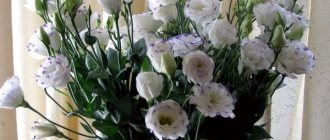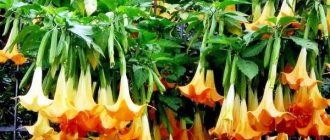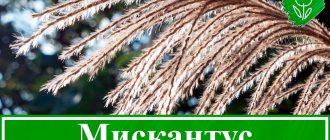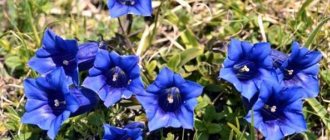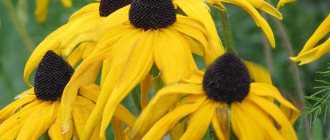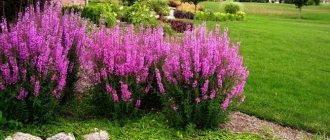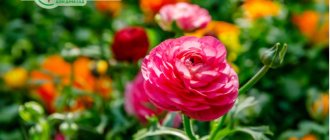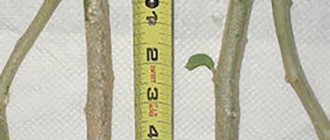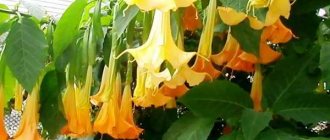In recent years, a beautiful plant, Brugmansia, has become popular. This is an original terrace flower that can be transplanted into open ground in summer. Its funnel-shaped flowers reach a length of 30 cm and smell wonderful. In summer, during one flowering period, it can produce several dozen flowers. In this article we will tell you how to grow Brugmansia - planting and care in the open ground and at home, how to ensure wintering, spring awakening, and provide a description of the varieties with photos.
Brugmansia description, photo
The crop is a tree-like shrub. It is particularly decorative, and with the right amount of knowledge, even beginners in gardening can cope with planting and care. The main problem that may arise during cultivation may be susceptibility to temperature conditions, in particular severe Russian frosts. Because of this feature, the name of the tub plant was formed - in the summer it is grown in open ground, in the winter it is transferred to the building in a tub.
Belongs to the Solanaceae family and is a separate genus of perennials. It is a tree-like shrub with elastic green stems, large double leaves (up to 30 cm in diameter), and bell-shaped, tubular flowers. Thanks to the shape of the inflorescences, it received a second name - angel's trumpet. The shades of the inflorescences are varied - from white peach to yellow-orange. Several hundred flowers are formed on one bush.
Informative! In addition to its unusual appearance, the flower has a number of medicinal properties. It can help relieve various inflammatory processes and has an antispasmodic and anesthetic effect. In its homeland, the shrub is used in religious rites, as well as in traditional medicine recipes.
Origin
The flower comes from South America. The name was given in honor of the 18th century Dutch botanist S. J. Brugmans.
Popular types and varieties - photos and descriptions
The genus Brugmansia includes 11 species. The most common types:
- Datura (lat. Brugmansia candida synonym Datura candida) (eng. Tree Datura) is also called Datura wood, angel trumpets, datura tree or snow-white Brugmansia. It is an annual plant, probably native to Central America. At low temperatures, the above-ground part freezes out and grows back in the spring. In Russia it is usually grown in pots and containers. Brugmansia is grown in open ground in the southern regions. The datura is decorated with strong-smelling cup-shaped flowers.
- Datura stramonium is a herbaceous plant of the nightshade family, growing in wastelands and landfills. Other names are stupid grass, stupefying grass, crazy grass, badura, thistle. Wild perennials grow up to 100 cm in height. The flower is large, cup-shaped, reaches a length of 10 cm, and ends with triangular petals. Flowers “look” up and to the sides and emit an unpleasant odor. The flowers appear on a widely branched stem and bloom throughout the summer, usually until the end of September. Green leaves are about 30 cm long, the leaf blades are pointed and jagged along the edges. Fruits from August to October.
- Brugmansia arborea is becoming increasingly popular. This is a perennial belonging to the Solanaceae family. It is distinguished by fragrant, funnel-shaped flowers hanging down. The flower can reach 30-45 cm in length and looks impressive against the background of dark green, 25 cm leaves. Due to its similarity to annual daturas, Brugmansia was originally classified as a Datura species.
- Golden Brugmansia (Brugmansia aurea) is a species suitable for decorating large spaces - terraces or gardens. A funnel-shaped flower with a golden color adorns the bush. The species Brugmansia aurea is a vigorous grower, which should be taken into account when choosing; in natural conditions it reaches 5 meters. The stems are tough, erect, initially green, eventually becoming woody. The leaves are large, soft, toothed, mossy, green or gray-green. The first buds are formed when the shoots are 100 cm long. The flowers are large - from 14 to 50 cm in length, overhanging (which distinguishes brugmasje from their relatives datur). Cold resistance is not bad, the species can withstand temporary temperature drops to -1, -2 ° C, Some breeding varieties do not tolerate temperatures below +5 °C.
- Brugmansia bloody (red) (Brugmansia sanguinea) - also characterized by fast, lush growth. At home, it reaches a height of 150 cm. The decoration of the species is odorless orange-red flowers reaching a length of 20 cm. Each flower has golden-yellow veins. Flowering occurs in winter - January-March, so this species can delight with its beauty in home greenhouses.
- Fragrant Brugmansia (fragrant) (Brugmansia suaveolens) - can reach a height of 3-5 m. The species is distinguished by its magnificently fragrant flowers, cream, hot pink, yellow, and white in color. The sweet scent of the flowers is strongest in August.
Brugmansias are charming flowers that can be grown in balcony boxes, large pots, or transplanted into open ground in the warm season. Majestic plants are suitable for balconies and terraces. Shrubs growing in pots, showered with bright flowers, look gorgeous. Showy potted plants often produce a pleasant aroma, further enhancing summer fun. A cut flower is suitable for decorating an apartment.
South American Brugmansia shrubs reach 4 m in height in nature, woody species can eventually grow to 10-12 m. Brugmansia in a pot, grown at home, grows up to 2 m. A variety of species, varieties and interspecific hybrids are available for sale, flowering throughout the summer, until the first frost.
There are many hybrid varieties available with white, pink, yellow, red, orange or salmon flowers.
Some varieties of Brugmansia have double flowers:
- "Angels Summertime" Angels Sumerttime;
- Angels Innovation;
- "Angels Suprise" Angels Suprise;
- Angels Sunexplosion;
- "Rosa Zauber" Rosa Zauber;
- "Susie Underhill" Susie Underhill;
- "Summedaft" Sommerduft;
- "Miss October" Miss October;
- "Barcarole" Barcarole;
- "Bolero" Bolero;
- "Bridesmaid" Bridesmaid;
- "Fandango" Fandango;
- "Edna" Edna.
Varieties with colored leaves are also decorative:
- "Maya" Maya;
- "Snowbank" Snowbank;
- "Sublime" Sublime;
- "Sunset" Sunset.
Brugmansia species, varieties
The family includes 11 varieties that are visually similar to each other. But each variety differs in genetic and morphological characteristics.
Brugmansia tree is the most common species, famous since the mid-18th century. This species is also the most popular among gardeners. There are a large number of varieties, from which numerous varieties have been bred. In the wild world, a particular species is considered completely destroyed and is found only in culture. The standard tree height is 4-5 m, some varieties do not exceed 2 m. Among cultivated trees, the norm is considered to be a bush height of 1.5-2 m. Selected varieties can have terry multi-tiered foliage and flowers of various colors.
Brugmansia snow-white. The dazzling white inflorescences are considered a special feature. Some selection varieties have fringed flowers, painted in light pink, yellow, and light orange tones. The height reaches 2m, the shoots are located close to the ground.
Golden is a bright representative of tall varieties, capable of reaching over 6 m in height. The color of the corollas varies from lemon to orange.
Blood red Brugmansia. This species can hardly be called a shrub because its height can reach 14m. The corollas have a memorable color - the main shade is orange, and the veins are a bright yellow tone. The variety received its name due to the rich red edging that outlines the edge of the flower. This variety is the only representative that has no aroma.
Unlike other fragrant varieties, it is pollinated by small hummingbirds. The blood-red variety is the most frost-resistant species, easily tolerating low temperatures and retaining vitality during short-term frosts.
Multi-colored is the owner of the largest outstanding flowers. The length of the flower reaches 50cm. The variety acquired its name due to the shade of the corolla - at the base the tube has a light green tint, smoothly turning into creamy yellow, and the limb of the petal turns into a rich scarlet or orange tint.
Brugmansia is fragrant - it has, compared to other varieties, small but very fragrant flowers. The corollas are white or yellow, at the stage of budding they are light pink. The height of the bush is 1.5 m, but the variety grows quite quickly, and the stems have the peculiarity of branching. It is the most frost-resistant, unpretentious variety with a subtle, refined aroma.
Interesting! For cultivation in botanical gardens and greenhouses, breeders have developed several hundred different varieties with different colors, shapes and sizes.
What kind of Brugmansia is she?
Brugmansia belongs to the Solanaceae family. Recently, it belongs to its own genus Brugmansia arborescens, but previously it was classified as a genus of Datura. It is cultivated exclusively for decorative purposes due to its spectacular appearance. It is a tree-like plant, which is decorated with bright, tubular, bell-shaped flowers. South America is considered the birthplace of this flower.
It is also known as the Stupefying Tree. The reason for this is the presence of intoxicating elements in all its parts. And because of the large tubular flowers, which are distinguished by their extraordinary beauty, the tree is also called Angel Trumpets.
Brugmansia is planted in open ground only in southern countries where there are no frosty winters. These are: the Caucasus, Crimea and Southern Europe. However, in our regions it can be grown in tubs or large flowerpots, placing it indoors for the winter. It can easily serve as a decoration for a terrace or balcony. The height of the tree does not exceed two meters, but when grown in the wild, it can have a height of three meters.
Active vegetative growth begins from April to August. In order for the plant to have a neat, tidy appearance, it is subject to regular trimming, during which the side stems are removed. The leaves have an elongated elliptical shape, are supported by long petioles, and the leaf surface is slightly fleecy. The leaves are entire with pointed ends and clearly visible light green veins.
The root system is a tight lump of root shoots, from which powerful roots develop, penetrating several meters from the upper layers of the soil. The flowers are drooping, tubular in appearance and look like large bells. The leaf circumference is about 15 cm, the length is up to 25 cm. They exude a very pleasant aroma, which intensifies in the evening. The color of the flowers can be two-tone, pink, yellow or white. Flowering begins in mid-summer and occurs gradually, in several stages.
When growing a plant in open ground, the formation of buds begins in August after the temperature drops in the evening. Brugmansia can withstand temperatures up to +5 degrees without significant damage to flowers and leaves.
You should know that this crop is considered prohibited for growing in public places in many countries due to the fact that it is a poisonous plant. The aroma of its flowers can cause headaches, and substances found in essential oils cause hallucinations. This is especially important to know for people who have small children.
Some people call it “the trumpets of angels”, as the flowers are distinguished by their extraordinary beauty and pleasant aroma. By planting such a tree at home or in the garden, you will receive a separate bright element with which you can decorate any place on your site, and growing it is not particularly difficult.
Features of growing Brugmansia
To obtain lush flowering, you need to have information about some tricks in matters of growing:
- Even the most experienced gardeners face flowering problems. Quite often, newly formed buds fall off. The main reason may be insufficient lighting, in which the stems of the bush become weakened and thinned. The next reason for the shedding of buds may be a sudden change in temperature. Therefore, you should not move it to another place at the budding stage.
- A mature shrub has a spreading, luxurious crown reaching a diameter of 2 m, and when choosing a location, you need to remember this important aspect.
- The tree does not require neighbors; it exhibits excellent decorative features, growing alone.
- The rich aroma notes in the room take on a suffocating hue. It is important that the wintering area has sufficient area and good ventilation. Otherwise, the suffocating odor can cause headaches and insomnia.
- It is classified as poisonous. Any part (especially the seeds) contains toxic psychotropic components that have hallucinogenic properties. Thanks to these features, the ancient Indians used whisks for healing purposes.
Remember! Given the toxicity, pruning the stems must be done with gloves to avoid individual allergic reactions.
Useful properties and toxicity of Brugmansia
At home, the local population uses Brugmansia as a medicinal plant. Its hallucinogenic properties are widely used for religious rituals. It should be borne in mind that all parts of the plant are highly poisonous. They contain high levels of scopolamine and atropine. The rich aroma of Brugmansia flowers can cause a severe headache.
Brugmansia planting
The tree needs conditions as close as possible to its natural habitat.
When to plant
Plant in open soil after the threat of night frosts has passed. The average air temperature should not fall below 10 degrees Celsius. Approximately such weather conditions are observed in mid-May.
Selecting a location
It is preferable to plant in a semi-shaded area with diffused sunlight. In open sunlight, the plant will slow down its growth and development. However, it should be remembered that it is preferable to have a sufficient amount of lighting and the absence of wind drafts that can damage fragile stems.
Soil for Brugmansia
Fertilizing the soil always brings good performance. Regardless of the acidity level, a small amount of dry chicken manure is added to the soil. Initially, seedlings are grown in pots. As it grows, several transfers are made to larger containers. The earthen lump is preserved; fresh soil is poured into the resulting voids with the addition of a portion of chicken manure.
The plant prefers a neutral, loose, fertile substrate. The planting site can be prepared in advance by adding a mixture of loamy soil, humus, and peat in a ratio of 1:1:2. Before planting, for prevention, the soil is shed with a weak solution of potassium permanganate.
For your information! The range of species today has been quite reduced due to intense human activity. The main danger is deforestation. However, thanks to the work of breeders and long enough cultivation, complete disappearance is not dangerous.
Lighting
The flower is a light-loving variety that thrives in sufficient sunlight. Based on this, the landing area should be well lit or with light partial shade. In dense shade, it stops forming buds and begins to actively grow greenery.
Landing technology
After the seedlings planted in pots have acquired strong roots, they can be transferred to open ground to a permanent planting site. To check the condition of the roots, inspect the earthen ball. If it is completely entwined with roots, then the plant is ready for replanting.
Given its heat-loving nature, the bush is transferred into open ground into special containers or large tubs. This method allows you to quickly bring the bush indoors in case of unexpected cold weather. After adapting to street conditions, the seedlings begin to grow rapidly, gain strength and height.
When growing in a tub, you should choose a container with a volume of at least 10 liters. The composition of the soil should be as nutritious as possible, preferably a mixture of humus and loamy substrate. It is not recommended to plant in peat mixture. The ground is also treated in advance with a light manganese solution.
A more mature bush, after awakening in winter, is slowly taken out into the air with the onset of spring warmth. You should start with a minimum period of stay, gradually increasing the time. When transplanting, frost-resistant varieties can be planted directly into the soil. To do this, they begin preparing the land in April, adding ash and complex fertilizers with a high content of nitrogen components.
Remember! Planting directly into the soil eliminates unnecessary work. However, the variety must be resistant to weather conditions.
Landing
Seeds and seedlings of attractive Brugmansia species are available for sale. After purchasing a seedling about 30 cm high, it is transplanted into a large pot.
What kind of pot is needed for Brugmansia:
- a seedling about 30 cm high is transplanted into a 10-liter pot;
- large seedling – volume 40 liters.
Suitable soil for planting Brugmansia is humus soil with a pH of 6-7.5.
Brugmansia, grown in open ground, prefers soils:
- fertile;
- well drained (with the addition of sand);
- preferably slightly acidic or neutral.
When placing Brugmansia on the balcony, it is worth remembering that on a small balcony, majestic plants may have too little space for free development.
Brugmansia care
For abundant and healthy flowering, the crop needs proper care. For these purposes, it is necessary to have information about proper watering, fertilizing, and pruning the bush.
Watering
The tree does not require special watering, but you must remember:
- In hot summer conditions, watering should be plentiful. The dry surface of the earth signals the approaching time of watering. After the heat of the day subsides, adult bushes can be sprayed. During the flowering period, it is important to avoid getting moisture on the inflorescences. Young seedlings are sprayed daily;
- During the cold period, watering depends on the wintering conditions. If there is a bright, heated room, the summer watering regime is maintained. Only those bushes that are located in close proximity to heating devices are irrigated. In a cooler building, watering is kept to a minimum. It is important to ensure that the soil does not dry out and that the leaves remain elastic.
Top dressing
The tree has an excellent appetite and squeezes out all the nutritional components from the soil. It is for this reason that regular fertilizing with complex mineral fertilizers should be carried out. You can use organic fertilizers - an aqueous solution of cow manure in a ratio of 1:10.
The first feeding procedure is carried out in the spring. During the summer period, fertilizing is carried out with a complex of mineral and organic fertilizers at intervals of every ten days. During the flowering period, increase the amount of phosphorus and potassium components in fertilizers.
When kept in winter under conditions of full heating, fertilizing is carried out once a month. In cold winter conditions, fertilizing is completely canceled.
Important! There are manifestations of yellow stripes, stains or spots on the foliage of the bush. In case of such manifestations, unscheduled feeding with nitrogen-containing preparations is carried out.
Trimming
Special pruning is not required, but the basic rules for caring for and propagating a tree involve periodic cutting of the stems. In addition, pruning promotes abundant formation of buds and lush flowering. February and mid-March are considered the optimal period for removing injured and dead stems.
The center stem cannot be pruned; only the side stems can be removed. An unwritten rule among gardeners is not to remove the V-shaped stems and horizontal shoots on the top of the tree, as these are where the buds form.
Brugmansia requirements for conditions
The problem is that the bush does not tolerate cold at all. The plant is usually grown in open soil or in containers, and in winter it is transferred to home conditions. In southern latitudes, for example, in Crimea, you don’t have to do this; the flower can easily withstand a warm winter without frost.
In the northern regions, the bush is immediately planted in a separate container so that it can be moved indoors in winter. The hassle of relocating will be worth it when the magnificent giant bells with an attractive scent bloom.
When choosing a site for summer planting of an exotic beauty, you should take into account the location of the sun and shade: it should be in diffuse shade and protected from the wind. The heat-loving shrub prefers sufficient lighting, but does not like drafts. Flowers may not like bright sun, and in dense shade the mass of leaves will increase.
Branches heavy with flowers need additional support. On summer, and especially on hot days, it is recommended to water the bushes with heated water.
Tall spreading bushes with large elastic leaves and impressive roots need a sufficient amount of moisture. In some cases, the flower is sprayed at sunset, protecting the blossoming inflorescences from moisture.
When planning a place for planting Brugmansia, one must take into account that the plant requires space: its crown spreads up to 2 m in diameter. Close proximity to other flowering bushes should also be avoided. In the container at the base of the royal gramophones you can plant a long-blooming begonia, also a big lover of water, which will be comfortable in the shade of a spreading bush.
It is desirable that the soil on the site be rich and loamy. Brugmansia must be fertilized regularly - at least twice a month, using liquid mineral fertilizer, adding wood ash, and during intensive flowering - with the addition of potassium and phosphorus.
In summer, the flowering shrub does not need pruning. But in the winter season, the plant kept at home produces many tender, powerless shoots that will need to be removed in the spring. The optimal time for this is March. Moreover, it is necessary to cut off excess shoots before new ones begin to appear.
First, get rid of dried and stunted branches. Full shoots are cut by a third; with their help, the plant can be propagated. You should not overdo it with thinning, so as not to reduce the abundant flowering. The branches are pruned for the first time a year after the first flowering. For generous flowering, you need to keep the lateral shoots horizontally, which usually bear the most flowers.
Methods for propagating Brugmansia
The culture can be propagated by seeds, air layering, and cuttings.
Seeds
Reproduction by sprouting seeds is not an easy process. The seed method is the most labor-intensive of all propagation methods in terms of time of planting, germination, and time required to care for seedlings. Seed germination is uncontrollable. It may take 10, 20, 50 days before the first sprouts appear, or they may not sprout at all.
For seedlings grown by seed, flowering occurs only a year after planting. Hybrid varieties lose their characteristics when propagated by seed. It is precisely because of this amount of hassle and disadvantages that propagation of crops by seeds is not popular among gardeners. Sowing of seeds begins from January to March.
The sowing technology is as follows:
- preliminary preparation of the seed consists of soaking the grains in a growth stimulator;
- seeds are planted in the soil no deeper than 10 mm, moistened, covered with film, kept at a temperature of +20-25 degrees;
- After the first shoots appear, the film is removed, the sprouts are sprayed, after the formation of the fifth leaf, the seedlings can be transplanted into separate containers.
Remember! The culture is poisonous, posing a particular danger to children. Small children have a habit of putting all objects, especially beautiful flower buds, into their mouths. For a small organism, toxic juice can become extremely dangerous.
By layering
For propagation by layering, select a woody shoot, preferably one year old, and make a cross section on it. The incision is treated with a growth stimulator (Kornevin, Heteroauxin), moistened and wrapped with film. After 8 weeks, the shoot is checked for the formation of aerial roots. After the roots have formed, the shoot is cut off, the foliage is removed, and placed in a container with nutritious soil for rooting.
Cuttings
Many gardeners are actively interested in propagation by cuttings. This is the most popular propagation method, giving quick and effective results. Cuttings can be germinated all year round, but it is still recommended to harvest cuttings in the spring (when the sap begins to flow) or in the fall (before the first frost).
Before growing seedlings, it is necessary to carefully select and prepare cuttings. The best option is the upper annual shoots with buds. The length of the shoot should be 20-30 cm. Side buds are also suitable for germination, but such a seedling will flower only 1.5-2 years after cultivation.
Having selected the cuttings, cut them off, remove all the foliage, and place them in a bowl with settled water and a small amount of activated carbon. For faster germination, cuttings are kept in a warm room. As soon as white dots appear on the stems, which will later become roots, the cuttings can be transplanted into a container with soil. Keep the seedlings in a warm, illuminated room.
Interesting! Brugmansia and Datura are members of the same family. In 1753 they were classified as one class, and in 1973 they were separated after proven differences. However, in 1980, American breeders again combined these two crops into one class.
Growing from seeds
Sowing seeds should be done at the end of winter or at the very beginning of spring, after soaking them in warm water for 24 hours. For sowing, it is ideal to use a sand-peat mixture, and plant the seeds to a depth of no more than 1 centimeter.
The container in which the seeds are sown must be covered with a transparent film. Shoots appear after 10-30 days, after which the film should be removed. Transplantation into the ground occurs after the appearance of 4-5 leaves.
Specifics of planting Brugmansia from seeds in open ground and care
In the harsh climate of Russia, growing a flower in open soil is quite problematic. The heat-loving plant can hardly tolerate winter frosts, and young seedlings may even die. Seedlings are sown in specially prepared containers with nutrient soil. The soil should be as nutritious as possible, with a low percentage of acidity. Sow the seeds in moist, loosened soil, and then leave the containers in a warm place.
The timing of the appearance of the first shoots directly depends on the quality and freshness of the seed. Seedlings must be protected from drafts and cold winds. It is important to provide a sufficient amount of light; if there is insufficient lighting, the foliage of a young flower loses its brightness and the stems become elongated. Watering is carried out moderately, with warm water. It is important not to let the soil dry out. Stagnation of water in the soil is destructive. In hot, dry weather, spray with water from a spray bottle.
Fertilizer and pruning
For active and healthy growth of the tree during the season, it is advisable to feed it every week. It is possible to use ready-made multicomponent baits, such as potassium-phosphorus fertilizers. If the volume of the container in which Brugmansia grows is 5 liters, you need to add 1 teaspoon of fertilizer during watering.
You can determine the lack of nutrients by the leaves that have begun to turn yellow and the discarded buds. You can stop intensive feeding at the beginning of autumn.
To give the required shape to the crown and control growth, it is possible to trim the branches of the tree. This should be done in the spring, before the start of the growing season. Also, with the help of pruning, it is possible to stimulate the flowering of the plant; to do this, you need to remove the shoots that have grown at the base of the trunk.
How to care for Brugmansia in winter
Winter maintenance of a tree has certain rules related directly to the plant’s love of warmth and fear of frost. In autumn, when the air temperature drops to +5 degrees, the bushes are brought indoors. The best option would be a bright, cool building. Watering is reduced by half from summer. Even in the harshest winter, the plant does not go into a dormant state. Additional lighting must be provided. The bush can be trimmed as needed. Daylight should be about 15 hours, and the temperature should not be lower than +15 degrees.
Know! Even in winter, the plant needs feeding, watering and irrigation. It is especially important to do this if there are heating devices in close proximity to the tank.
Brief description of cultivation
- Temperature regime . In summer, the air temperature should be close to room temperature, and in winter - no more than 15 degrees.
- Air humidity level . It must be increased (at least 60 percent).
- Illumination . Needs plenty of bright but diffused sunlight. A south window is ideal, but the bush needs shading.
- Watering . The soil mixture in the pot should be slightly moist all the time.
- Substrate . Nutritious and light, a drainage layer must be placed at the bottom of the pot.
- Fertilizer . Needs regular feeding.
- Transplant . Carry out as needed, sometimes two or three times a year.
- Reproduction . By apical cuttings and seed method.
- Trimming . Requires systematic formative pruning.
Brugmansia in the flower garden. Care, reproduction, diseases, pests.
Where to buy, price
On the territory of Russia, the bush is a rare inhabitant. In open areas it can be found on the coast of the Caucasus. In the southern regions, true varieties of Datura are most often found. In flower shops you can find small trees called Datura Tree-like.
Although in truth these shrubs are hybrid varieties of snow-white or fragrant Brugmansia. The first type has pendulous inflorescences, the second - half drooping.
Seeds can be purchased in specialized stores or in an online store. The cost varies from 100 rubles to 800 rubles, depending on the variety and characteristic features of the species.
Features of the external structure
During its growth and development, Brugmansia develops into a shrub or a small beautiful tree with a wide crown. The large leaves of the plant, arranged in tiers on the shoots, are ovoid in shape and can reach a length of 30 centimeters.
Depending on the species, the leaves may be pubescent. At the initial stage of development, up to 50-150 centimeters in height depending on the type of plant, Brugmansia grows with one trunk, after which it begins to branch.
The amazingly beautiful Brugmansia flower is a distinctive feature of the culture. Reaching 50 centimeters in length, the tubular-bell-shaped inflorescences acquired a second name due to their shape - “Angel Trumpets”.
The impressive color palette of Brugmansia flowers can range from white to orange, red or lilac with a variety of shades. During one summer flowering period, more than two dozen simple, double or two-tier flowers can bloom.
Speaking about the description of Brugmansia, one cannot fail to mention the characteristic very strong, but really pleasant aroma of flowers, which becomes more intense in the evening. From the beginning of summer to mid-autumn, the flowering of this plant lasts, ending with the ovary of fruits containing seeds.
It is practiced to grow Brugmansia outdoors in large pots and then move the flower indoors during the frost period.
It is important to remember that caring for the plant requires some caution, since all parts of it, especially the leaves and seeds, are poisonous. In this regard, it is recommended to carry out all manipulations with flowers using gloves.
Brugmansia pests and diseases (treatment)
The main pests are considered to be spider mites (under home conditions), as well as slugs, aphids, caterpillars, and whiteflies that eat the leaves and flowers of the plant, despite the toxic substances present in them. The main sign of the appearance of pests is damage and falling of inflorescences and foliage. It is difficult to cope with the problem using traditional methods.
Effective results are shown by specialized complexes such as Agravertin, Fiopharm, Actellik, etc. It is necessary to carefully examine the back side of the foliage and the condition of the internodes. Often, two treatments for 7 days correct the situation, eliminating pests.
The tree is often susceptible to diseases and pest attacks, so preventive measures should be taken to preserve the beauty and health of the plant:
- do not plant in close proximity to other plants;
- arrange regular air baths, even in winter;
- Once every two months, water the trunk with an aqueous solution of slaked lime (1 gram of product per 1 liter of water).
Most often, the bush is affected by gray rot. The main cause of the disease is excess soil moisture. Once the disease is detected, you should stop watering and let the soil dry (within a week). All affected stems must be removed. Treatment with a special product called “Topaz” helps greatly against gray rot.
For your information! Maintenance problems are not always related to disease or pests. Falling buds may indicate insufficient lighting, lack or excess moisture. If the shrub does not form buds for two to three years, the soil may contain excess nitrogen, which provokes an abundant growth of greenery.
Watering
Despite the fact that the plant tolerates hot weather well, it is extremely sensitive to lack of moisture and requires regular watering. In order for Brugmansia to feel good and please the owner, the soil must be constantly moist.
Otherwise, there is a risk that the plant will lose leaves and almost. Bushes growing in pots or other containers require daily watering. When the heat drops, you need to let the top layer of soil dry before watering.
Brugmansia in landscape design, combination with other plants
The bushes look great against the backdrop of carpet flower beds and flower lawns. The stunning view is formed against the backdrop of plain hedges. You can plant the trees in pre-prepared barrels, place the containers at the front entrance of the site or along the perimeter of the gazebo.
The shrub looks nice next to other representatives of flower crops. For example, you can plant hibiscus nearby. Dahlias and roses will also become worthy neighbors of Brugmansia.
Painless transplant
To successfully transplant Brugmansia, it must be done by transshipment, in early spring, at the moment when the root system has completely entwined the earthen ball. For soil, it is better to select universal mixtures enriched with peat and compost.
Do not forget about creating drainage; for this you need to pour a layer of expanded clay onto the bottom of the pot or hole. After planting, it is necessary to water the plant abundantly.
Planting and caring for Brugmansia in the Moscow region
This tropical beauty categorically does not tolerate frost, however, having a winter garden or an insulated loggia, it is quite possible to grow a beautiful, strong tree. In the autumn and winter season it is better to keep it in greenhouse conditions.
If this is not possible, it is necessary to remove all young stems and foliage and move the container to a room where the air temperature does not fall below three degrees Celsius. And after the threat of returning frosts has passed (in the Moscow region this time comes by mid-June), they can be taken out into the open air. Water with warm water. Every week they are fed with complex mineral fertilizers.
Care by month
February
In February, the plant needs to be “awakened” - moved closer to the light, and started to water moderately. It is worth replanting Brugmansia in fresh fertile humus soil, preferably with an almost neutral pH (6-7.5), shortening the shoots and, if necessary, overgrown, very thickened roots.
If there is not enough space, cut last year's shoots short (to a length of 20-30 cm).
April-March
In March, the plants “come to life”. When they begin to grow, you can start fertilizing with fertilizer for plants with decorative leaves (it contains a lot of nitrogen). Brugmansia can be planted in the ground when the threat of frost has passed.
May
At the beginning of May, the plants are gradually hardened off on the street (balcony) for at least a week. In the second half of the month they are left outdoors. If unexpected frosts are expected, the plants must be covered or brought indoors.
June July
For specimens several years old, a 20-40 liter container with large holes in the bottom is required. It is worth loading the pots with stones so that they are stable, and placing them on stands (the water will not drain too quickly, but it will not remain in excess for too long).
You can bury the pot in the ground to the middle of the height (the roots will grow through the drainage holes) in a place that has been previously fertilized with garden compost or manure. You can also plant the plant in the ground without a container.
During the season, young plants reach a length of more than a meter (in the photo there is a plant on the balcony).
Water the plants deeply, several times a day in hot weather. Otherwise, they will quickly fade and the flower buds will fall off. From May to mid-August, every 4 days we use a multi-component fertilizer for flowering plants, containing a lot of potassium and phosphorus (starvation causes yellowing and falling leaves).
In June-August, trim the tips of the shoots by 15-20 cm so that they have a slightly woody lower part. We prepare cuttings from them.
September
From the beginning of the month, we completely stop feeding and greatly limit watering.
October
Without waiting for frost to be announced, we dig up plants growing in the ground and trim the ends of the roots and branches. We plant it in a container and sprinkle it with peat or place it in a box covered with jute. Plants (including those from balconies and terraces) are transferred to cool rooms.
November
If potted specimens are moved (without pruning) to the veranda, they will bloom for a short time. Bushes do not require intensive watering. You can chop them up a little and put them in the pantry.
Forum, reviews
There are not many reviews on growing Brugmansia on flower forums. Many are not at all familiar with this exotica, while others consider it capricious and are simply afraid to have this African beauty. In the climate of Russia, all exotic lovers grow the tree as a tub crop. Many breeders complain of frequent spider mite infestations, which are difficult to remove at home. The path to obtaining a beautiful flowering tree is quite long, it can take more than one year. But beauty compensates for all the effort and time spent.
Conclusion
The shrub is a very beautiful exotic plant. With each year of his life, his characteristics are revealed with renewed vigor. Therefore, it is quite sad when, due to the climatic conditions of its growth, the crop is increasingly grown as an annual. When grown at home, the flower feels quite good, but the winter period brings a lot of trouble. Therefore, it is very important to fully have information on the issue of Brugmansia planting and care in the open ground, otherwise everyday problems and mistakes will not allow you to fully enjoy the delights of having foreign exotics in the house.
Growing and care
Brugmansia is thermophilic, it can be grown in the ground in the garden and in a pot on the terrace or balcony. The plant is formed in the form of a large bush or small tree. Growing Brugmansia, although labor-intensive, is very rewarding; plants can reach a height of almost 3 m, each producing hundreds of flowers per season!
Selecting a location
Due to their large size, it is important to provide the plants with a suitable location where they will show off their qualities most beautifully.
At home, Brugmansia grows best in a secluded, sunny place. In shaded positions, the bush may not develop properly and may stop blooming. At noon, when the sun is brightest, it is worth slightly shading the plant to prevent leaf burns.
In the garden, Brugmansias do not like windy positions; strong winds can destroy delicate leaves and flowers, and even knock over a huge bush growing in a pot. The species prefers semi-shaded positions, preferably in an eastern exposure or under tree branches.
Watering, fertilizing
Brugmansia requires a constantly moist substrate. In hot weather, water it more often to keep the flowers and leaves in good condition. Standing in full, hot summer sun can be uncomfortable for the plant. In such conditions, it is necessary to water 2-3 times a day; the plant consumes a huge amount of water due to its large leaves.
In mid-summer, the best growing location is in sheltered partial shade.
In order for the plant to bloom until autumn, it requires careful care. Very rapid growth and the production of a large number of large flowers requires the application of fertilizers, without which good results cannot be expected. Brugmansias require fertilizer on a regular basis - every week, along with watering, they are fertilized with multicomponent compounds, but in a slightly lower concentration than recommended on the packaging. A suitable fertilizer should contain:
- 15-17% nitrogen;
- 30% potassium;
- 10% phosphorus,
- magnesium and trace elements.
The plant develops well after applying Azofoska fertilizer. Apply 1 teaspoon of fertilizer per 5-6 quart pot.
You can also feed with plant infusions. Systematic fertilizers combined with regular watering will allow the plant to develop many flower buds. Stop feeding Brugmansia in September.
How to trim
Brugmansia needs to be trimmed properly. Flowers will appear on the upper shoots. The better the plant bushes, the more buds it has. A sign that flowers will appear on this shoot is the presence of asymmetrical leaves. Removing this year's growth that grows on the main stem or at its base also stimulates flowering.
Brugmansia is pruned before winter. Only the tender tops are cut off, and in the spring they are shortened further. For a biennial plant, we leave 2 thick shoots.
If Brugmansia is young, you should wait until it grows and only then remove the top. We also consistently remove all sprouts growing on the main shoot.
In subsequent years, we leave 3-4 branches about 1 m long). The plant may also have a single shoot that branches at the top. However, such a tree is not very stable and when grown in a pot it easily turns over. It is better to bury such a specimen in the garden with a container in the summer or plant the plant in the ground. The shoots on the trunk should be removed.
Advice. By removing faded flowers, Brugmansia will bloom more abundantly.
Overwintering a houseplant
Before the first frost, we move cold-sensitive Brugmansia indoors, for example, to a bright veranda or loggia. Plants tolerate wintering at temperatures of 5-10 degrees Celsius. Water less often in winter, be careful with moderately moist substrates - avoid over-moistening. Plants can overwinter at home - in a bright, cool room.
Wintering a plant dug from open ground
If Brugmansia is grown in open ground, in the Moscow region, in the middle zone, for the winter it is dug up and planted in large containers, for example, in a bucket. The plant produces thick tuberous roots that can be stored like dahlia tubers. Since the roots of the plant spread widely, you can transplant it into a wide basin. In this case, the above-ground part is cut off at a height of 20 cm. Stored in a cool room, with a temperature of about 10 ° C, with access to light, watering occasionally.
If it is not possible to provide a bright room, Brugmansia can overwinter in a dark cellar if it is dry and draft-free. After such storage, the plant usually does not begin to bloom longer.
Growing problems, diseases, pests
- A strong wind can break branches and throw the pot over; you need to choose a windless place.
- Heavy rain damages the leaves (it is safer to place the plant under a light roof).
- The most common growing mistakes that lead to yellowing and falling leaves are too much sunlight, lack of nutrients and water.
- The presence of pests on the undersides of leaves is also the cause of massive leaf fall. Spider mites and thrips can harm Brugmansia (their presence is indicated by small spots and cobwebs on yellowed leaves). Also, aphids and whiteflies greatly weaken plants. We destroy them with insecticides (for example, Aktara). When spraying chemicals in confined spaces, be especially careful, do not live there for the period of time indicated on the product packaging, and use personal protective equipment when working.
Growing using cuttings
To propagate Brugmansia, you can use stem cuttings, which are best cut in May.
Young shoots with 3-4 internodes are ideal, with the lower foliage cut off and the upper foliage left in half. The resulting cuttings must be dipped in rooting hormone and only then immersed in a peat-perlite mixture to a depth of 3 centimeters.
It is advisable to cover the cuttings with a transparent bag and leave them in a well-lit place. You should not overdo it with watering, but the soil should be moist enough. Rooting of cuttings occurs on average after a month. The first flowering of a new plant occurs after 1-2 years
Poisonous properties
Brugmansia is distinguished by its poisonous properties, due to which it can cause harm to human health. Therefore, it is important to wear gloves when working with it.
If the plant is grown at home or in the garden, you need to choose a place where none of the family members can accidentally touch it.
It is important to keep the flower away from small children and pets, to whom it is impossible to explain the danger of contact with this crop.
Even the slightest piece of grass that enters the body of a person or animal causes severe poisoning, even death.
The danger arises due to the fact that the plant contains toxic substances, namely atropine, scopolamine and hyoscyamine.
Brugmansia is a very poisonous plant
Description of the plant
Brugmansia is a climbing plant with long stems arranged alternately.
The leaves have a green tint, an oblong shape, and in some varieties the foliage is jagged along the edges. They can reach 30 cm in length.
In summer, buds form on the branches. During the flowering period, they bloom, resulting in flowers of white, pinkish, and yellow colors.
They have a tubular appearance, are quite long, and emit a strong aroma that literally fills the room.
The aroma of Brugmansia is strong and persistent
